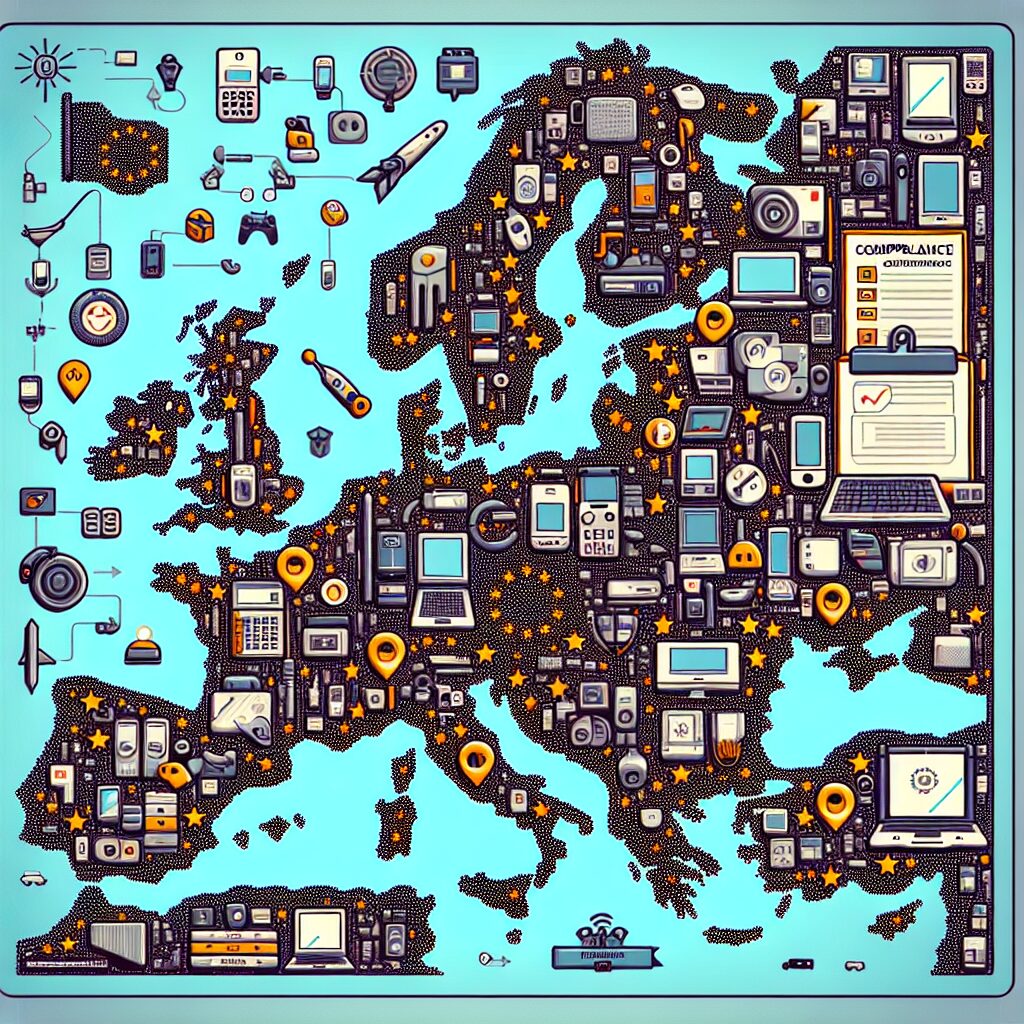About eldris
epr.eldris.ai leads the EPR sector, in fast, automated, AI Agent EU Complaince. LUCID Packaging, WEEE, and Battery Compliance for Brands, E-Commerce and Service based businesses expanding into the EU.
In This Article
- The WEEE Directive applies to all producers of electrical and electronic equipment within or selling into the EU.
- You must register nationally, report placed goods, and finance proper e-waste handling.
- Amazon sellers and online shops are not exempt—WEEE compliance remains a legal duty.
- Variations exist between Member States; tailor compliance based on your sales geography.
- Eldris offers a reliable way to manage and simplify WEEE compliance.
What Is the WEEE Directive?
Definition and EU Purpose
The WEEE Directive, formally known as the Waste Electrical and Electronic Equipment Directive, is an essential piece of environmental legislation within the European Union. It is aimed at reducing the amount of electronic waste by promoting the reuse, recycling, and recovery of electrical and electronic equipment (EEE). This legislation applies to producers, distributors, and sellers of EEE across the EU, placing legal responsibilities on them to collect, treat, and properly dispose of their products after consumer use.
Put in place to combat the growing ecological impact of e-waste, the WEEE Directive serves both as a tool for environmental protection and as a framework for harmonising producer responsibilities among EU Member States. Since its initial implementation in 2002—and its revised version (WEEE Directive 2012/19/EU)—this directive ensures that manufacturers and distributors contribute to a circular economy by financing the end-of-life processes for their products.
In practice, this means producers must register in the appropriate national WEEE registers, report data about placed goods, finance take-back and recycling schemes, and label products in accordance with the regulation.

Who Is Considered a WEEE Producer?
Manufacturer, Importer, Seller Explained
You are considered a **WEEE producer** if you place electrical or electronic devices on the EU market under your brand, whether through manufacturing, importing, or selling via distribution platforms such as Amazon or eBay. This includes physical retailers, B2B suppliers, and even foreign companies targeting EU consumers online.
If you import devices into the EU from a non-EU country or manufacture products locally and sell them under your own name, you fall under the definition of a “producer” as per the WEEE Directive. Furthermore, if you sell products directly to end-users in other EU countries from another Member State, you could be considered a “distance seller” and subject to compliance in each country targeted.
One of the most misunderstood aspects of the regulation is that Amazon and similar platforms are not legally responsible for the registration or recycling duties—they fall on the producer.
“Becoming a WEEE producer isn’t just about physical product origin—selling into the EU makes you responsible under law.”
WEEE Legal Obligations in the EU
Under the WEEE Directive, each producer has several core duties. These legal obligations include:
- National Registration: You must register with the responsible authority in every EU country where you sell EEE.
- Reporting: You must periodically report the total weight and categories of electrical goods placed on the market.
- Financing e-waste collection: The cost of collecting and treating WEEE must be borne by the producer through collective or individual schemes.
- Marking Obligations: Products must be labelled with the ‘crossed-out wheelie bin’ symbol and your producer registration number.
- Information Dissemination: Producers must provide end-users and recyclers with proper disposal and treatment information.
Most critically, these obligations remain binding regardless of the producer’s physical location—non-EU companies must comply if they sell into the EU market.
Do Online and Amazon Sellers Qualify?
Online marketplaces have significantly expanded cross-border commerce, especially in the consumer electronics space. However, this convenience has come with regulatory consequences. If you are selling EEE through platforms like Amazon or Shopify into the EU, you are very likely classified as a WEEE producer—even if the products are stored or fulfilled by third-party logistics providers.
Amazon sellers must take note: under the WEEE Directive, you are independently responsible for compliance in each Member State where you are offering products. The regulation makes no distinction between a traditional importer and a digital marketplace seller.
Specific market surveillance authorities are increasingly targeting non-compliant online vendors. Amazon, in some jurisdictions, now mandates WEEE registration proof before allowing electronics listings to go live.
This evolving scrutiny makes it critical for all digital retailers and D2C ecommerce brands to preemptively make their WEEE arrangements—or risk facing enforcement actions, including sales bans and financial penalties.
EU State-by-State Compliance Variations
While the WEEE Directive sets an EU-wide framework, the actual implementation is controlled by individual Member States. This means the registration process, data formats, reporting schedules, and fees vary from country to country.
For example, Germany requires WEEE compliance registration via Stiftung EAR, with comprehensive documentation and audits. France mandates eco-contributions paid to an eco-organisation like Ecologic or Ecosystem. Italy, on the other hand, uses the CdC RAEE registry and mandates B2B reporting as a separate category.
Changes in enforcement pace and procedural complexity often confuse producers seeking pan-European compliance. It is thus not sufficient to register in one EU country—you must follow each national scheme corresponding to your sales reach. Non-EU providers especially must work with Authorised Representatives to fulfil obligations locally.
For a practical breakdown per country, visit Learn more about EU EPR and WEEE Regulatory Compliance.
WEEE Registration: Step-by-Step Guidance
To comply with the WEEE Directive, businesses must complete a structured registration and reporting journey. Here’s a recommended step-by-step approach:
- Identify Producer Responsibility: Confirm whether you qualify based on production, importing, branding, or cross-border selling criteria.
- Designate Authorised Representatives: Non-EU companies must appoint a legal entity within each relevant country.
- Register with National Registers: Submit documents and obtain a Producer Identification Number in each target Member State.
- Classify Products: Assign your electrical items to correct WEEE categories based on function and component type.
- Join a WEEE Compliance Scheme: Collective Producer Responsibility Organisations (PROs) help manage recycling obligations efficiently.
- Label Products: Apply the proper markings to all applicable devices before market entry.
- Track and Report Data: Use internal systems to gather product weight, category, and transactional data for quarterly or annual reports.
For detailed registration walkthroughs, refer to Read a related article.
Understanding Your Reporting Duties
Once registered, reporting becomes a recurring responsibility. You must declare each unit of EEE placed on the market per reporting period, typically quarterly or annually depending on national law. This includes:
- Category of equipment (e.g. IT, household appliances, medical devices)
- Weight per unit
- Date of placement
- Method of distribution (e.g. online, B2B, retail)
Accurate reporting is essential, as underdeclaration may lead to fines, while overreporting inflates compliance costs. Implementing enterprise resource planning (ERP) systems linked with sales and inventory data helps automate accurate reports.
Consistent documentation lowers the risk of audit-based penalties and can minimise long-term financial exposure. Moreover, many PROs offer reporting dashboards and technical assistance at no extra charge.
Labels, Symbols, and Marking Requirements
Product labelling is not optional. The WEEE Directive requires that all applicable electronic equipment carry the “crossed-out wheeled bin” symbol. This icon indicates that the product must not be disposed of with general household waste.
In addition to the symbol, products must bear a mark showing the date of placement on the market, typically identified through a bar underneath the bin symbol. Some countries, like France and Spain, mandate including your national WEEE registration number or compliance logo on packaging or instruction manuals.
Ignoring these marking requirements can result in customs seizures or refusal of entry into retail channels. Labels must be indelible and visible throughout product life, even after disposal.
Penalties for Non-Compliance
Failure to comply with WEEE obligations can lead to severe consequences. National enforcement agencies have the authority to issue the following sanctions:
- Fines: Monetary penalties per product or per day of non-compliance
- Sales Restrictions: EU-wide product bans or takedowns from digital marketplaces
- Legal Prosecution: Repeated offences may result in criminal charges under environmental law
- Reputational Risk: Public naming in regulatory watchdog reports affecting brand trust and investor interest
Producers should be proactive. Non-compliance consequences not only affect business operations but also delay market entry, especially important for new launches. Given increasing environmental scrutiny globally, the reputational costs of WEEE breaches can outweigh even the fines.
Several Member States now publish online lists of compliant producers. Failure to appear jeopardises business relations and licensing negotiations. See Official EU overview of WEEE responsibilities for updated national enforcement trends.
How Eldris Simplifies WEEE Compliance
Eldris is a trusted partner in helping businesses navigate the complex landscape of international e-waste regulation. Our compliance platform offers:
- Multi-country registration fulfilment with local representation
- Automatic reporting integration with inventory software
- Product classification support and category auditing
- Marking consultancy and design compliance
- On-demand legal updates and regulatory alerts
By leveraging Eldris, producers can reduce compliance risks while streamlining administrative overhead. Whether you’re a rapidly growing ecommerce brand or an established OEM, our experts ensure that you’re always aligned with both EU and UK versions of the WEEE Directive without manual guesswork.
Schedule a free compliance consultation via EU Authorised Representative explained and remove the complexity from environmental responsibilities.
Conclusion: Take Responsibility as a Producer
[CONCLUSION_CONTENT]
Managing your obligations under the WEEE Directive is no longer optional—it is a regulatory must. If you’re placing electronic equipment into any EU market, you’re a WEEE producer and must take steps to ensure compliance. From proper registration and product labelling to contextual state-by-state resolutions, strict diligence is key.
Fortunately, with the right guidance and system partnerships, this process doesn’t need to be cumbersome. Embrace your producer responsibility as part of a greener, legally sound operational strategy. The risks of avoidance far outweigh the initial efforts involved in creating a compliant, efficient end-of-life management process for your electronic products.
Great guide on weee-directive-eu-producer-explained-interactive – Community Feedback
Who qualifies as a WEEE producer under EU rules?
Any business manufacturing, importing, or selling electrical and electronic equipment (EEE) in EU markets typically qualifies as a WEEE producer and must comply with the Directive’s obligations.
What are key responsibilities for EU WEEE producers?
EU WEEE producers must register with national registers, finance collection and treatment of end-of-life equipment, report sales volumes, and ensure correct marking and information for consumers.
Is WEEE compliance mandatory for online sellers?
Yes, if you place electrical or electronic products on any EU market, including via online marketplaces, WEEE compliance obligations apply regardless of where your business is established.










